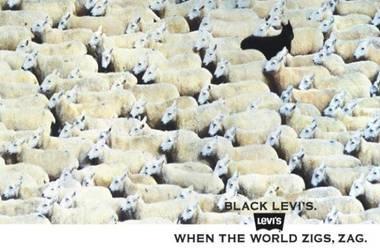As a B2B marketer, there comes a point, often relative early in the career when suddenly a world of business books and gurus opens up. There’s a whole collection of marketing libraries to devour with core tenants from the likes of Godin, Sinek, Carnegie, Heinz…
There is a great deal of excellent thinking and applicable approaches in these weighty tomes. (Let’s be real though, like most of us I have not read them all. I’ve read chapters, I’ve listened to highlights on Blinkist and just sometimes I have got stuck in to 80%+ on Audible).
Where things get more interesting is in what I’m going to call the second wave of guru influence. These come later, probably consumed slower and not in quite such a big pile.
One of the gems in this group is Zag by Marty Neumeier.
The book itself has plenty of good stuff in it (admission time, like many of these, I’ve read/listened to some of it but not all). But the key message is in the title – don’t follow the crowd.
The history of Zig and Zag in marketing goes back even further. It’s roots can be traced back to a Levi Jeans advert from 1982 <gasp>.

What’s the point of all this? Why kick over skeletons at the back of the marketing closet?
Well… because after having now spent the last few years working in and around the sector relating to the production of renewable energy, I have seen first hand that herd mentality still reigns supreme.
Look at the renewables supply chain and there is an endless supply of tech vendors offering to save time and money via some sort of data analytics and smarts. The norm is to go down a route of green or blue branding, images of data flying out of turbines and a list of services that all sound super geek chic. Accompanying this product story is the business growth narrative, with the history of the Angel, Seed, Series A… you know it!
Here’s the thing. That same plethora of small plucky, vendors are all chasing the same small number of large global enterprises who plan, develop and operate renewable power.
Take a step back and look at this rationally. There’s a big group of vendors all looking and sounding similar. Most of them are seeking the same big exit via acquisition. But it’s only going to happen for a fortunate few. This can only end in tears.
Why is this happening? Perhaps it’s a by-product of a decision by consensus. Perhaps it’s seen as the safe route. Or perhaps, it’s even more fundamental, that there is only one perceived way forward.
This perceived route to safety is paradoxically extremely dangerous. By not standing out, the long odds of getting picked up become just that bit longer. Why not give your brand the best chance it can have within your sphere of influence?
Bland is out. Brand is in. Here’s the thing: B2B does not have to mean Boring 2 Boring.

Book now to give your business a health check
Our health check will shine a torch around the inside of your sales and marketing set up.
We will identify frictions and highlight what support would help.
What if the approach was different?
How can we be bold in B2B? Well, to help bring some answers, I’ve scanned the web and curated the following nuggets.
1. You’ve got to know the rules before you can break them
The point here is a bit of self awareness is necessary. For example, Jonathan Goodman is in the niche of fitness marketing. He talks through the example of a personal trainer who found their approach wanting. Initially, the trainer went to market using technical messaging. The focus was on detailed sport-tech information on the design of their fitness programme. What the trainer found was the clients didn’t care. They came because they wanted to get in shape, it didn’t matter how their problems went away as long as they did.
To grab attention, focus the early stage messaging on the prospects’ benefits.
2. Admit your flaws
This can sound scary, especially for a tech company that prides itself on its technological prowess. Not only does this sound scary, it is scary! However, I believe it’s worth pushing through the fear. It is worth it because on the other side is authenticity. And authenticity breeds trust. A bit like a restaurant that has hundreds of reviews and in among the glowing 5 star recommendations there is the odd complaint.
This idea has been researched by Elliot Aronson who ran a study where coffee was deliberately spilled during a quiz. The clumsy coffee spilling participant was seen as more likeable than the non-spilling control group.
The idea of the importance of emotion is not just for marketing but also for sales. Buyers are more likely to purchase, pay more and stay loyal when there is an emotional connection with the brand.
3. Become comfortable that some ideas might sound bad at first
Rafael Gracioso Martins writes about herd mentality in the context of VC world. I believe his thoughts are equally valid in other industries.
“The best ideas quite often sound very bad. The crowd wisdom routinely rejects the best ideas, going for uniformity and compliance within the status quo. A decade ago, staying in a stranger’s house or letting a stranger drive you across town was considered a bad idea. We even tell our children to “not talk to strangers”. Both seemingly horrible ideas led to the creation of AirBnB and Uber, each valued at Tens of Billions of Dollars.”
Rafael Gracioso Martins
Rafael goes on to make the following important point. Not only should we entertain what may at first appear like bad ideas, but we should beware the bandwagon. We don’t need an AirBnB for dogs but we do need clean energy and a cure for cancer. Our finest minds should be focused on fixing the real tangible problems.
4. What this is not is being different for different’s sake.
This zag zag thing is not binary. Tom McCallum makes the point that there are degrees of zag and it’s not about being a polar opposite in order to be effective. Being different from the herd does not necessarily mean being provocative, does not mean shock tactics and so does not imply the stance is always going to be hard for the market to swallow.
So what is the move from here?
If you’ve got this far and thinking of putting some zag through your brand then you are already on the cusp of making a substantial difference away from the herd.
My thoughts are this: the first step away from the herd is to be yourself.
Yes, I know, that might sound trite but I do believe it. In my own marketing for Make the Break, I’ve gone out of my way to write what I think, in the language I use. It’s helped me stand out and get noticed across an industry in recent years.
But I’ve also seen this work first hand with my client brands. Only last week, I was working with a founder who was practising the pitch deck for a soon-to-be-announced new entrant brand. While doing the run through, we got to the slide with the business mission. On first attempt to talk through the slides, the founder kept to the script. On the second attempt, they stopped halfway and said …
“No, what this is really about is I believe this business, giving what I know and who I am connected to, is the route to which I can have the most impact for good change in the world.” A. Founder
Now THAT, is a mission statement.
